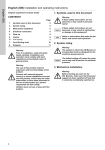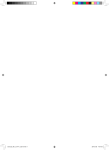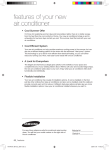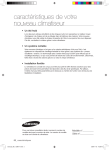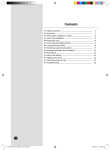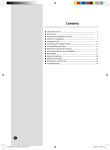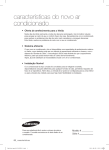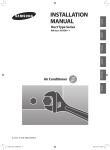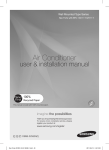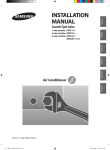Download Samsung ND220HHXEA User Manual
Transcript
Duct Type Series
BIG duct : NDHH
Air Conditioner
user manual
imagine the possibilities
Thank you for purchasing this Samsung product.
To receive more complete service, please
register your product at
www.samsung.com/register
E S F I P D G Ne Po Hu R DB98-33763A(2)
Big Duct type_IB_E_33763-1.indd 21
2011-09-12 �� 5:34:23
features of your new
air conditioner
• Cool Summer Offer
On those hot sweltering summer days and long restless nights, there is no better escape
from the heat than the cool comforts of home. Your new air conditioner brings an end to
exhausting hot summer days and lets you rest. This summer, beat the heat with your own
air conditioner.
• Cost Efficient System
Your new air conditioner not only provides maximum cooling power in the summer, but can
also be an efficient heating method in the winter with the advanced “Heat pump” system.
This technology is up to 300% more efficient than electrical heating, so you can further
reduce its running cost. Now, meet year-round needs with one air conditioner.
• Flexible installation
Duct type air conditioner is designed to be slimmer and offers different solutions for any
shape room allowing for specific air flow requirements. Also, the air intake can be set up on
either the bottom or rear of the unit, so there is more flexibility in installation.
For easy future reference write the model and serial number
down. You will find your model number on the right side of
the air conditioner.
Model #
Serial #
02_ features
Big Duct type_IB_E_33763-1.indd 1
2011-06-20 오전 11:25:51
safety information
To prevent electric shock, disconnect the power before servicing, cleaning, and installing the air conditioner.
SAFETY INFORMATION
Before using your new air conditioner, please read this manual thoroughly to ensure that you know how to
safely and efficiently operate the extensive features and functions of your new appliance.
Important safety symbols and precautions:
WARNING
Hazards or unsafe practices that may result in severe personal injury or
death.
CAUTION
Hazards or unsafe practices that may result in minor personal injury or
property damage.
CAUTION
To reduce the risk of fire, explosion, electric shock, or personal injury when
using your air conditioner, follow these basic safety precautions:
ENGLISH
Because the following operating instructions cover various models, the characteristics of your air
conditioner may differ slightly from those described in this manual. If you have any questions, call your
nearest contact center or find help and information online at www.samsung.com.
Do NOT attempt.
Do NOT disassemble.
Do NOT touch.
Follow directions carefully.
Unplug the power plug from the wall socket.
Make sure the machine is grounded to prevent electric shock.
Call the contact center for help.
Note.
These warning signs are here to prevent injury to you and others.
Please follow them carefully.
After reading this section, keep it in a safe place for future reference.
safety information _03
Big Duct type_IB_E_33763-1.indd 2
2011-06-20 오전 11:25:52
safety information
WARNING
SEVERE WARNING SIGNS
Do not place the air conditioner near hazardous substances or equipment
that releases free flames to avoid fire, explosions or injuries.
• Potential risk of fire hazard or explosion.
Do not install the outdoor unit at an unstable place or elevated surface where
there is potential risk of falling.
• If the outdoor unit falls, it may cause personal injury or loss of property.
Failure or damage may occur if any changes or modification that is not
stated in the installation manual was performed. In this case, user will be
responsible for the repair expenses.
Install the air conditioner away from direct exposure to sunlight, heating
apparatus, and humid places.
• Hang curtains on windows to boost cooling efficiency and to avoid the risk of electric
shock.
Do not cut the power plug and connect to a different power cable.
Do not yank the power cable and touch the power plug with hands.
• Potential risk of fire or electric shock.
Never use a damaged or dusted power plug, power cable, or loosened power
receptacle.
• Potential risk of fire or electric shock.
Install an exclusive circuit breaker and short-circuit breaker for the air
conditioner.
• Potential risk of electric shock or fire.
Do not insert anything such as fingers or branches into the air conditioner
vents while the air conditioner is running.
• Keep the children away from the air conditioner to prevent them from putting their finger
on the air conditioner. Potential risk of personal injury.
Ensure no water gets into the air conditioner.
• Potential risk or electric shock.
• If the water gets into the air conditioner, stop and unplug the power source immediately.
Turn off the air conditioner using the provided remote control or control
accessory (if provided). Do not unplug to turn off the unit (unless there is an
immediate danger).
Do not run the air conditioner for an extended period of time in a room with
the door closed or with babies, elderly or disabled people.
• Open the door or windows to ventilate your room at least once an hour to prevent oxygen
shortage.
The air conditioner is composed of moving parts. Keep children away from
the unit to avoid physical injury.
04_ safety information
Big Duct type_IB_E_33763-1.indd 3
2011-06-20 오전 11:25:52
Make sure that children take precautions against access to the air
conditioner and they do not play with the unit.
Do not clean the interior of air conditioner on your own.
• You may damage the parts which can cause electric shock or fire.
• Consult contact center for cleaning the interior of the air conditioner.
Do not connect the air conditioner with heating apparatus or attempt to
disassemble, remodel or repair it yourself.
Consult the place of purchase or contact center to install, reinstall or
disassemble the air conditioner.
ENGLISH
• Potential risk of malfunction, electric shock or fire. If repairs are needed, consult the
contact center.
• Improper installation carries a risk of unit malfunction, water leakage, electric shock or fire.
• If installing in specialty areas, such as a factory complex or saline coastal area, consult
the place of purchase or contact center for specific installation details.
• The units must be installed according to distances declared, in order to permit
accessibility from each side, either to guarantee correct operation of maintenance or
repairing products. The unit’s parts must be reachable and removable completely under
safety condition (for people or things).
Consult a dealer regarding the appropriate measures to prevent the allowable
concentration from being exceeded.
• If the refrigerant leaks, and cause the concentration limit to be exceeded, hazards due to
lack of oxygen in the room may result.
If the indoor unit gets wet, turn the power off immediately and call your
nearest contact center.
• Potential risk of fire or electric shock.
Always make sure that the power supply is compliant with current safety
standards. Always install the air conditioner in compliance with current local
safety standards.
Verify that the voltage and frequency of the power supply comply with
the specifications and that the installed power is sufficient to ensure the
operation of any other domestic appliance connected to the same electric
lines.
Use a rated circuit breaker only.
• Never use steel wires or copper wires as a circuit breaker. It may cause fire or unit
malfunctions.
Do not put undue stress or place heavy object on the power cable.
Do not bend the power cable excessively.
• Potential risk of fire or electric shock.
To protect the product from water and possible shock, you should keep the
power cable and the connection cord of the indoor and outdoor units in the
protection tube.
When opening or closing the front panel, use a stable stool and watch your
steps carefully.
Disconnect the air conditioner from power supply before it is repaired or
disassembled.
Clean the air conditioner after the inner fan stops operating.
• Potential risk of injury or electric shock.
safety information _05
Big Duct type_IB_E_33763-1.indd 4
2011-06-20 오전 11:25:52
safety information
WARNING
SEVERE WARNING SIGNS (Cont’d)
Use a receptacle that has a ground terminal. The receptacle must be used
exclusively for the air conditioner.
• Improper electrical grounding may cause electric shock or fire.
Be sure to ground the unit. Do not connect the ground wire to gas or water
pipes, lighting rods, or telephone grounding lines.
• If the unit is not properly grounded, electric shock may result.
If you smell burning plastic, hear strange sounds, or see smoke coming from
the unit, unplug the air conditioner immediately and call a contact center.
• Potential risk of fire or electric shock.
CAUTION
CAUTION SIGNS
Do not block or place items in front of the air conditioner. Do not step, hang
onto, or place heavy items on the air conditioner.
• Potential risk of personal injury.
If failure or damage occurs on the conditions of improper use not followed by
the installation manual, there will be an extra labor charge for installing and
construction.
• Potential risk of malfunction, electric shock or fire if repairs or installations are attempted
by a non-qualified service technician.
Do not spray flammable gases such as insecticide near the air conditioner.
• Potential risk of electric shock, fire or unit malfunction.
Do not open the front grille during operation.
• Potential risk of electric shock or unit malfunction.
Cool air should not flow directly towards people, pets, and plants.
• It is harmful to your health, pets, and plants.
Do not drink drain water coming out of the air conditioner.
• Potential risk of health hazard.
Do not allow children to climb on the air conditioner.
Do not use the air conditioner as a cooling precision instrument for food,
pets, plants, cosmetics or machinery.
Do not pull or give excessive shock to the air conditioner.
• Potential risk of fire, or unit malfunction and there are risk of personal injury because unit
may fall down.
Do not spray water directly on the air conditioner or use benzene, thinner or
alcohol to clean the surface of the unit.
• Potential risk of electric shock or fire.
• Potential risk of damage to the air conditioner.
Do not place any objects, especially containers with liquid.
06_ safety information
Big Duct type_IB_E_33763-1.indd 5
2011-06-20 오전 11:25:52
Do not touch the pipe connected to the air conditioner.
Install the indoor unit away from lighting apparatus using the ballast.
• If you use the wireless remote control, reception error may occur due to the ballast of the
lighting apparatus.
Install the outdoor unit where operating noise and vibration will not disturb
your neighbor and in a well-ventilated area with no obstacle.
• Potential risk of malfunction.
• Operating noise may disturb your neighbor.
Allow sufficient space for air circulation.
• Insufficient ventilation may result in poor performance.
ENGLISH
Make sure that there are no obstacles or covers that block the air conditioner.
If the power cable is damaged, the manufacturer or a qualified service
technician must replace it.
If a power outage occurs while the air conditioner is working, turn off the
power source immediately.
Max current is measured according to IEC standard for safety and current is
measured according to ISO standard for energy efficiency.
Check for damage on delivery. If damaged, do not install the air conditioner
and call the place of purchase immediately.
Keep indoor temperatures stable and not extremely cold, especially where
there are children, elderly or disabled people.
The packaging material and used batteries of the remote controller (optional)
must be disposed of in accordance with the national standards.
The refrigerant used in the air conditioner must be treated as chemical waste.
Dispose the refrigerant following national standards.
Have a qualified service technician install the air conditioner and perform a
trial operation.
Firmly connect the drain hose to the air conditioner for proper water
drainage.
Check for damages on the outdoor unit installation pad at least once a year.
• Potential risk of personal injury or property loss.
When using a wireless remote control, the distance should not be more than
7 meters from the air conditioner.
If the remote control is not used for a long period of time, remove the
batteries to prevent leakage of electrolyte.
When cleaning the outdoor unit, touch the heat exchanger radiator fins with
extreme care.
• Wearing thick gloves can protect your hands.
Make sure that the condensed water dripping from the drain hose runs out
properly and safely.
The appliance is not intended for use by persons (including children) with
reduced physical, sensory or mental capabilities, or lack of experience
and knowledge, unless they have been given supervision or instruction
concerning use of the appliance by a person responsible for their safety:
Young children should be supervised to ensure that they do not play with the
appliance.
safety information _07
Big Duct type_IB_E_33763-1.indd 6
2011-06-20 오전 11:25:52
safety information
CAUTION
CAUTION SIGNS (Cont’d)
Inspect the condition, electric connections, pipes and external case of the air
conditioner regularly by a qualified service technician.
Do not open doors and windows in the room being cooled during operation
unless necessary.
Do not block the air conditioner vents. If objects block the air flow, it may
cause unit malfunction or poor performance.
Make sure there are no obstacles under the indoor unit.
• Potential risk of fire or loss of property.
The air conditioner should be used only for the applications for which it has
been designed: the indoor unit is not suitable to be installed in areas used for
laundry.
Our units must be installed in compliance with the spaces indicated in the
installation manual to ensure either accessibility from both sides or ability to
perform routine maintenance and repairs. The units’ components must be
accessible and that can be disassembled in conditions of complete safety
either for people or things.
For this reason, where it is not observed as indicated into the Installation
Manual, the cost necessary to reach and repair the unit (in safety, as required
by current regulations in force) with slings, trucks, scaffolding or any other
means of elevation won’t be considered in-warranty and charged to end user.
Ensure the off-on and protection switches are properly installed.
Do not use the air conditioner if damaged. If problems occur, immediately
stop operation and disconnect the plug from the power supply.
If the air conditioner will not be used for an extended period of time (for
example, over several months), unplug the power from the wall.
Call the place of purchase or a contact center if repairs are needed.
• Potential risk of fire or electric shock if disassembly or repairs are attempted by a
non-qualified service technician.
08_ safety information
Big Duct type_IB_E_33763-1.indd 7
2011-06-20 오전 11:25:52
contents
Viewing your air conditioner
Using your air conditioner
11
cleaning and maintaining
the air conditioner
12
Appendix
14
installing your
air conditioner
ENGLISH
10
10 Big duct type
11 Tips on using your air conditioner
12 Maintaining your air conditioner
12
Periodical checks
13Internal protections via the unit control
system
14 Troubleshooting
15 Operation ranges
16 Installation part
16
This product has been determined to be in compliance with the Low Voltage Directive (2006/95/EC), and the Electromagnetic
Compatibility Directive (2004/108/EEC) of the European Union.
Correct Disposal of This Product
(Waste Electrical & Electronic Equipment)
(Applicable in the European Union and other European countries with separate collection systems)
This marking on the product, accessories or literature indicates that the product and its electronic accessories (e.g. charger, headset, USB cable) should not be
disposed of with other household waste at the end of their working life. To prevent possible harm to the environment or human health from uncontrolled waste
disposal, please separate these items from other types of waste and recycle them responsibly to promote the sustainable reuse of material resources.
Household users should contact either the retailer where they purchased this product, or their local government office, for details of where and how they
can take these items for environmentally safe recycling.
Business users should contact their supplier and check the terms and conditions of the purchase contract. This product and its electronic accessories
should not be mixed with other commercial wastes for disposal.
contents _09
Big Duct type_IB_E_33763-1.indd 8
2011-06-20 오전 11:25:52
viewing your air conditioner
Congratulations on the purchase of the air conditioner. We hope you enjoy the features of your air
conditioner and stay cool or warm with optimal efficiency.
Please read the user manual to get started and to make the best use of the air conditioner.
Big Duct Type
Air Outlet
Air intake
Your air conditioner may look slightly different from the illustration shown above depending
on your model.
10_ viewing your air conditioner
Big Duct type_IB_E_33763-1.indd 9
2011-06-20 오전 11:25:53
using your air conditioner
TIPS ON USING YOUR AIR CONDITIONER
Here are some tips that you would follow when using your air conditioner.
RECOMMENDATION
Cooling
• If current outside temperatures are much higher than the selected indoor
temperature, it may take time to bring the inner temperature to the desired
coolness.
• Avoid drastically turning down the temperature.
Energy is wasted and the room does not cool faster.
Heating
• Since the air conditioner heats the room by taking heat energy
from outdoor air, the heating capacity may decrease when outdoor
temperatures are extremely low. If you feel the air conditioner insufficiently
heats, using an additional heating appliance in combination with the air
conditioner is recommended.
Frost & De-ice
• When the air conditioner runs in Heat mode, due to temperature difference
between the unit and the outside air, frost will form.
If this happens:
- The air conditioner stops heating.
-The air conditioner will operate automatically in De-ice mode for
10 minutes.
- The steam produced on the outdoor unit in De-ice mode is safe.
No intervention is required; after about 10 minutes, the air conditioner
operates again normally.
ENGLISH
TOPIC
The unit will not operate when it starts to de-ice.
Fan
• Fan may not operate for about 3~5 minutes at the beginning to prevent
any cold blasts while the air conditioner is warming up.
High indoor/outdoor
temperatures
• If both indoor and outdoor temperatures are high and the air conditioner is
running in Heat mode, the outdoor unit’s fan and compressor may stop at
times. This is normal; wait until the air conditioner turns on again.
Power failure
• If a power failure occurs during the operation of the air conditioner, the
operating immediately stops and unit will be off. When power returns, the
air conditioner will run automatically.
Protection mechanism
• If the air conditioner has just been turned on after operation stops or being
plugged in, cool/warm air does not come out for 3 minutes to protect the
compressor of the outdoor unit.
using your air conditioner _11
Big Duct type_IB_E_33763-1.indd 10
2011-06-20 오전 11:25:53
cleaning and maintaining the
air conditioner
MAINTAINING YOUR AIR CONDITIONER
If the air conditioner will not be used for an extended period of time, dry the air conditioner to maintain it in
best condition.
1. Dry the air conditioner thoroughly by operating in Fan mode for 3 to 4 hours and disconnect
the power plug. There may be internal damage if moisture is left in components.
2. Before using the air conditioner again, dry the inner components of the air conditioner again
by running in Fan mode for 3 to 4 hours. This helps remove odors which may have generated
from dampness.
Periodical checks
Refer to the following chart to maintain the air conditioner properly.
Type
Description
Clean the air filter (1)
Indoor unit
Monthly
Every 4
months
Clean the condensate drain pan (2)
Thoroughly clean the heat exchanger (2)
Clean the condensate drain pipe (2)
Replace the remote control batteries (1)
Clean the heat exchanger on the outside of
the unit (2)
Outdoor unit
Once a
year
Clean the heat exchanger on the inside of
the unit (2)
Clean the electric components with jets of
air (2)
Verify that all the electric components are
firmly tightened (2)
Clean the fan (2)
Verify that all the fan assembly is firmly
tightened (2)
Clean the condensate drain pan (2)
The checks and maintenance operations described are essential to guarantee the
efficiency of the air conditioner. The frequency of these operations varies according to the
characteristics of the area, the amount of dust, etc.
(1) T
he described operations should be performed more frequently if the area of installation
is very dusty.
(2) T
hese operations must always be performed by qualified personnel. For more detailed
information, see the Installation Manual.
12_ using your air conditioner
Big Duct type_IB_E_33763-1.indd 11
2011-06-20 오전 11:25:53
Internal protections via the unit control system
This internal protection operates if an internal fault occurs in the air conditioner.
Type
Description
The internal fan will be off to against cold air when the heat pump is
heating.
De-ice cycle
The internal fan will be off to against cold air when the heat pump is
heating.
Anti-protection of
internal battery
Protect compressor
The compressor will be off to protect internal battery when the air
conditioner operates in Cool mode.
ENGLISH
Against cold air
The air conditioner does not start operating immediately to protect the
compressor of the outdoor unit after it has been started.
If the heat pump is operating in Heat mode, De-ice cycle is actuated to remove frost from
an outdoor unit that may have deposited at low temperatures.
The internal fan is switched off automatically and restarted only after the de-ice cycle is
completed.
using your air conditioner _13
Big Duct type_IB_E_33763-1.indd 12
2011-06-20 오전 11:25:53
appendix
TROUBLESHOOTING
Refer to the following chart if the air conditioner operates abnormally. This may save time and unnecessary
expenses.
PROBLEM
SOLUTION
The air conditioner does not
operate immediately after it
has been restarted.
• Because of the protective mechanism, the appliance does not start operating
immediately to keep the unit from overloading.
The air conditioner will start in 3 minutes.
The air conditioner does not
work at all.
• Check that the power plug is properly connected. Insert the power plug into the
wall socket correctly.
• Check if the circuit breaker is switched off.
• Check if there is a power failure.
• Check your fuse. Make sure it is not blown out.
The temperature does not
change.
• Check if you selected Fan mode.
Press the Mode button on the remote control to select another mode.
The cool (warm) air does
not come out of the air
conditioner.
• Check if the set temperature is higher (lower) than the current temperature. Press
the Temperature button on the remote control to change the set temperature.
Press the Temperature button to decrease or increase the temperature.
• Check if the air filter is blocked by dirt. Clean the air filter every two weeks.
• Check if the air conditioner has just been turned on. If so, wait 3 minutes. Cool air
does not come out to protect the compressor of the outdoor unit.
• Check if the air conditioner is installed in a place with a direct exposure to sunlight.
Hang curtains on windows to boost cooling efficiency.
• Check if the cover or any obstacle is not near the outdoor unit.
• Check if the refrigerant pipe is too long.
• Check if the air conditioner is only available in Cool mode.
• Check if the remote control is only available for cooling model.
The fan speed does not
change.
• Check if you selected Auto or Dry mode.
The air conditioner automatically adjusts the fan speed to Auto in Auto/Dry mode.
Timer function does not set.
• Check if you press the Power button on the remote control after you have set the time.
Odors permeate in the room
during operation.
• Check if the appliance is running in a smoky area or if there is a smell entering from
outside. Operate the air conditioner in Fan mode or open the windows to air out the
room.
The air conditioner makes a
bubbling sound.
• A bubbling sound may be heard when the refrigerant is circulating through the
compressor. Let the air conditioner operate in a selected mode.
• When you press the Power button on the remote control, noise may be heard from
the drain pump inside the air conditioner.
Water is dripping from the
air flow blades.
• Check if the air conditioner has been cooling for an extended period of time with
the air flow blades pointed downwards. Condensation may generate due to the
difference in temperature.
Remote control is not
working.
• Check if your batteries are depleted.
• Make sure batteries are correctly installed.
• Make sure nothing is blocking your remote control sensor.
• Check that there are strong lighting apparatus near the air conditioner. Strong light
which comes from fluorescent bulbs or neon signs may interrupt the electric waves.
The air conditioner does not
turn on or off with the wired
remote control.
• Check if you set the wired remote control for group control.
The wired remote control
does not operate.
• Check if TEST indicator is displayed on the wired remote control. If so, turn off the
unit and switch off the circuit breaker. Call your nearest contact center.
The indicators of the digital
display flashes.
• Press the Power button on the remote control to turn the unit off and switch the
circuit breaker off. Then, switch it on again.
14_ appendix
Big Duct type_IB_E_33763-1.indd 13
2011-06-20 오전 11:25:53
OPERATION RANGES
The table below indicates the temperature and humidity ranges the air conditioner can be operated within.
Refer to the table for efficient use.
MODE
OPERATIONAL TEMPERATURE
INDOOR
OUTDOOR
IF OUT OF CONDITIONS
Condensation may occur on
the indoor unit with risk to have
either water blow off or drops on
the floor.
COOLING
18˚C to 32˚C
-5˚C to 43˚C
80% or less
HEATING
27˚C or less
-20˚C to 24˚C
-
Internal protection triggers and
the air conditioner will stop.
-
Condensation may occur on
the indoor unit with risk to have
either water blow off or drops on
the floor.
DRYING
18˚C to 32˚C
-5˚C to 43˚C
ENGLISH
INDOOR HUMIDITY
The standardized temperature for heating is 7˚C. If the outdoor temperature drops to 0˚C or below,
the heating capacity can be reduced depending on the temperature condition.
If the cooling operation is used at over 32˚C(indoor temperature), it does not cool at its full capacity.
appendix _15
Big Duct type_IB_E_33763-1.indd 14
2011-06-20 오전 11:25:53
5. Hang the indoor unit to the suspension bolts between two nuts.
Installation Part
Note
Piping must be laid and connected inside the
ceiling when suspending the unit. If the ceiling is
already constructed, lay the piping into
position for connection to the unit before
placing the unit inside the ceiling.
6. Screw the nuts to suspend the unit.
Indoor Unit Installation
7. Adjust level of the unit by using measurement plate for all 4 sides.
It is recommended to install the Y-joint before installing the
indoor unit.
Note
1. Place the pattern sheet on the ceiling at the spot where you
want to install the indoor unit.
Note
For proper drainage of condensate, give a 1° slant
to the left or right side of the unit which will be
connected with the drain hose, as shown in the
figure. Make a tilt when you wish to install the drain
pump, too.
Since the diagram is made of paper, it may shrink
or stretch slightly due to temperature or humidity.
For this reason, before drilling the holes maintain
the correct dimensions between the markings.
1°
Drain hose port
Performing Leak Test & Insulation
2. Insert bolt anchors, use existing ceiling supports or
construct a suitable support as shown in figure.
Concrete
Insert
Hole in anchor
Hole in plug
Suspension bolt(3/8" or M10)
Leak test
LEAK TEST WITH NITROGEN(before opening valves)
In order to detect basic refrigerant leaks, before recreating the
vacuum and recirculating the R410A, it’s responsible of installer
to pressurize the whole system with nitrogen(using a pressure
regulator) at a pressure above 4.1MPa(gauge).
LEAK TEST WITH R410A(after opening valves)
Before opening valves, discharge all the nitrogen into the
system and create vacuum. After opening valves check leaks
using a leak detector for refrigerant R410A.
3. Install the suspension bolts depending on the ceiling type.
E nsure that the ceiling is strong enough to
Leak check
support the weight of the indoor unit.
Before hanging the unit, test the strength
of each attached suspension bolt.
If the length of suspension bolt is more than
1.5m, it is required to prevent vibration.
If this is not possible, create an opening on
the false ceiling in order to be able to use it
to perform the required operations on the
indoor unit.
Ceiling support
Discharge all the nitrogen to create a vacuum and
charge the system.
Insulation
Once you have checked that there are no leaks in the system,
you can insulate the piping and hose.
4. Screw eight nuts to the suspension bolts making space for
hanging the indoor unit.
You must install the suspension bolts more than
four when installing the indoor unit.
Rubber
1. To avoid condensation problems, place T13.0 or thicker
Acrylonitrile Butadien Rubber separately around each
refrigerant pipe.
Note
Always make the seam of pipes face upwards.
No gap
NBR(T13.0 or thicker)
16_ installing your air conditioner
Big Duct type_IB_E_33763-1.indd 15
2011-06-20 오전 11:25:54
2. Wind insulating tape around the pipes and drain hose
avoiding to compress the insulation too much.
Insulation cover pipe
Insulation pipe
Drain pipe and Drain Hose Installation
1. Install the drain hose as short as possible.
Note
Indoor unit
be separated from the unit.
The drain pump connection port is used when
using a drain pump.
Be sure to overlap
the insulation
3. Finish wrapping insulating tape around the rest of the
pipes leading to the outdoor unit.
Cable-tie
Clamp
Flexible hose
ENGLISH
Insulation
2. Insulate the drain hose and then fix it as a picture.
Note
All refrigerant connection must be accessible, in order
to permit either unit maintenance or removing it
completely.
drainage of condensate.
Secure the drain hose with the cable-tie not to
Must fit tightly against
body without any gap.
4. The pipes and electrical cables connecting the indoor
unit with the outdoor unit must be fixed to the wall with
suitable ducts.
Give a 10mm slant to the drain hose for proper
Assemble flexible hose with clamps between
indoor unit and drain pipe.
Flexible hose clamps should be assembled
tightly to prevent being loosen. If it is loosen,
it may cause water drops.
5. Select the insulation of the refrigerant pipe.
Insulate the gas side and liquid side pipe referring to the
thickness according to the pipe size.
Indoor temperature of 30°C and humidity of 85% is the standard condition.
If install in a high humidity condition,use one grade thicker
insulator by referring to the table below.
If installing in an unfavorable conditions,use thicker one.
Insulator’s heat-resistance temperature should be more than
120°C.
Insulation Type(Heating/Cooling)
Pipe
Pipe size
Liquid Φ6.35~Φ9.52
pipe Φ12.7~Φ50.80
Φ6.35
Φ9.52
Φ12.70
Φ15.88
Φ19.05
Φ22.23
Gas
Pipe
Φ25.40
Φ28.58
Φ31.75
Φ38.10
Φ44.45
Standard
High humidity
[30°C,85%]
[30°C,over 85%]
EPDM,NBR
9t
←
13t
←
13t
19t
Φ50.80
25t
19t
Remarks
Internal temperature
is higher than 120°C
32t
25t
38t
Install the insulation not to get wider and use
the adhesives on the connection part of it to
prevent moisture from entering.
Wind the refrigerant pipe with insulation tape
if it is exposed to outside sunlight.
Install the refrigerant pipe respecting that the
insulation does not get thinner on the bent part
or hanger of pipe.
Add the additional insulation if the insulation
plate gets thinner.
Hanger
Additional insulation
a
a×3
Refrigerant pipe insulation
installing your air conditioner _17
Big Duct type_IB_E_33763-1.indd 16
2011-06-20 오전 11:25:55
Drainpipe Connection
Wiring Work
Without the drain pump
1. Install horizontal drainpipe with a slope of 1/100 or more and
fix it by hanger space of 1.0~1.5m.
2. Install U-trap at the end of the drainpipe to prevent a nasty
smell to reach the indoor unit.
3. Do not install the drainpipe to upward position.
It may cause water flow back to the unit.
1~1.5m
Hanger
H≥50mm
1H
2
Drain Pipe
Cleaning hole
Power and communication cable connection
1. Before wiring work, you must turn off all power source.
2. Indoor unit power should be supplied through the
breaker(ELCB or MCCB+ELB) separated by the outdoor
power.
ELCB: Earth Leakage Circuit Breaker
MCCB:Molded Case Circuit Breaker
ELB:Earth Leakage Breaker
3. The power cable should be used only copper wires.
4. Connect the power cable{1(L), 2(N)} among the units within
maximum length and communication cable(F1, F2) each.
5. Connect V1, V2(for DC12V) and F3, F4(for communication)
when installing the wired remote Control.
Outdoor
Unit
Ceiling Horizontal drainpipe
more than 1/100 slope
Wired Remote
Control
220-240V~
or
With the drain pump
MCCB+
ELB
1. The drain pipe should be installed within 300mm to 550mm
ELCB
from the flexible hose and then lift down 20mm or more.
2. Install horizontal drainpipe with a slope of 1/100 or more
Indoor Unit 1 Indoor Unit 2
and fix it by hanger space of 1.0~1.5m.
3 Install the air vent in the horizontal drainpipe to prevent
WARNING
Power off before connecting any wires;
Indoor PBA will be damaged while V1,V2,F3,F4
short each other.
water flow back to the indoor unit.
Note
Indoor Unit 3
h ELCB : Essential Installation
You may not need to install it if there were proper
slope in the horizontal drainpipe.
4 The flexible hose should not be installed upward position,
Selecting compressed ring terminal
it may cause water flow back to the indoor unit.
Air vent
200mm
or more
300mm or less
20mm
or more
Within
330mm
Flexible hose
Ceiling
1~1.5m
Hanger
B
D
d1
E F L
d2
t
Nominal Nominal
dimensions dimensions Standard
Standard
Standard
Standard
Allowance
Allowance
Allowance
Allowance
for cable for screw dimension
Min.
Min. Min. Max. dimension
dimension
dimension
(mm)
(mm)
(mm)
(mm)
(mm2)
(mm)
(mm)
(mm)
(mm)
(mm)
Horizontal drainpipe
more than 1/100 slope
1.5
2.5
Centralized Drainage
4
Without the drain pump
1. Install horizontal drainpipe with a slope of 1/100 or more and
fix it by hanger space of 1.0~1.5m.
2. Install U-trap at the end of the drainpipe to prevent a nasty
smell to reach the indoor unit.
100mm or more
Silver solder
4
4
4
4
6.6
8
6.6
8.5
4
9.5
±0.2
3.4
±0.2
4.2
±0.2
5.6
+0.3
-0.2
+0.3
-0.2
+0.3
-0.2
1.7
±0.2 4.1 6 16
4.3
2.3
±0.2
6 6 17.5
4.3
3.4
±0.2
6 5 20
4.3
+0.2
0.7
0
+0.2
0.8
0
+0.2
0.9
0
Specification of electronic wire
Power supply
MCCB
ELB or ELCB
Power
cable
Earth
cable
Communication
cable
Max : 242V
Min : 198V
XA
X A, 30mmA
0.1 sec
2.5mm2
2.5mm2
0.75~1.5mm2
Decide the capacity of ELCB(or MCCB+ELB) by below formula.
Ceiling
Horizontal drain
pipe more than 1/100 slope
With the drain pump
1. Install main air vent at the front of the farthest indoor unit from
the main drain when installed indoor units are more than 3.
2. You may need to install individual air vent to prevent water
flow back at the top of each indoor unit drainpipe.
1~1.5m
Hanger
Individual
air vent
Main air vent
330mm
or less
Main drainpipe
Centralized horizontal drainpipe
(more than 1/100 slope)
18_ installing your air conditioner
Big Duct type_IB_E_33763-1.indd 17
The capacity of ELCB(or MCCB+ELB) X [A] = 1.25 X 1.1 X ∑Ai
T X : The capacity of ELCB(or MCCB+ELB).
T ∑Ai : Sum of Rating currents of each indoor unit.
T R efer to each installation manual about the rating current of indoor unit.
Decide the power cable specification and maximum length
within 10% power drop among indoor units.
n
Coef×35.6×Lk×ik
k=1
1000×Ak
∑(
)<
10% of input
voltage[V]
T Coef: 1.55
T Lk : Distance among each indoor unit[m],
Ak: Power cable specification[mm2], ik : Running current of each unit[A]
h Run transmission wiring between the indoor and outdoor units
through a conduit to protect against external forces, and feed
the conduit through the wall together with refrigerant piping.
2011-06-20 오전 11:25:57
Indoor Unit Setting
Additional Functions
1. Before installing the indoor unit, assign an address to the
indoor unit according to the air conditioning system plan.
2. The address of the indoor unit is assigned by adjusting
MAIN(SW01, SW02) and RMC(SW03, SW04) rotary switches.
K1 K2 K3 K4
No.
g The designs and shape
are subject to change
according to the model.
SW05
SW02
SW06
SW03
SW04
SW07
The MAIN address is for communication between the
indoor unit and the outdoor unit. Therefore, you must
set it to operate the air conditioner properly.
You can set the MAIN address from ‘00’ to ‘99’ by mixing
SW01 and SW02.
The MAIN address from ‘00’ to ‘99’ should differ from
each other.
Check the indoor unit address on the plan that you are
to install and set the address according to the plan.
OFF
Use
K2
Centralized controller
Not use
Use
K3
-
-
-
K4
Drain pump
Not use
Use
g K1 OFF
K5 K6 K7 K8
No.
You may not need to set MAIN address if you selected
Auto Address Setting from the outdoor unit: see details
on the outdoor unit installation manual.
For Example
Not use
Heating mode : Setting temperature compensation
value = 0°C
Thermo OFF Fan OFF
Setting MAIN Address
Note
SW05
ON
External room sensor
ENGLISH
SW01
Function
K1
When MAIN address is set as “12”.
SW06
Function
ON
OFF
K5
Heating Current Temperature
Compensation
+2°C
+5°C
K6
Filter Time
1000
hours
2000
hours
K7
Hot Water Heater
Not use
Use
K8
-
-
-
Setting RMC Address
The SW03 and SW04 RMC switch is the address setting
switch for controlling the indoor unit with the centralized
controller.
You must set the SW03, SW04 and K2 switch when using
the centralized controller.
You don’t have to set the SW03 and SW04 RMC switch
when not using the centralized controller.
For Example
K9K10K11K12
No.
When RMC address is set as “12”.
SW07
SW03
Function
ON
OFF
K9
Indoor Expansion Valve
For Heating Stop
Fix 160 step
0 or 160 step
K10
Wired Remocon Group
Master
Not use
Use
K11
External control
Not Use
Use
K12
External Control Output
Thermal ON
Operation ON
SW04
installing your air conditioner _19
Big Duct type_IB_E_33763-1.indd 18
2011-06-20 오전 11:25:57
QUESTIONS OR COMMENTS?
COUNTRY
ALBANIA
AUSTRIA
CALL
42 27 5755
0810 - SAMSUNG
(7267864, € 0.07/min)
OR VISIT US ONLINE
AT
8000-7267
OR VISIT US ONLINE
AT
www.samsung.com
800-7267
www.samsung.com
8-800-77777
www.samsung.com
COUNTRY
LATVIA
www.samsung.com ESTONIA
CALL
BOSNIA
05 133 1999
www.samsung.com/
be (Dutch)
LITHUANIA
www.samsung.com/
be_fr (French)
www.samsung.com RUSSIA
8-800-555-55-55
www.samsung.com
BULGARIA
07001 33 11
www.samsung.com GEORGIA
8-800-555-555
www.samsung.com
CROATIA
062 SAMSUNG (062 726 7864)
www.samsung.com ARMENIA
0-800-05-555
www.samsung.com
CZECH
800 - SAMSUNG (800-726786)
www.samsung.com AZERBAIJAN
www.samsung.com
DENMARK
70 70 19 70
www.samsung.com KAZAKHSTAN
BELGIUM
02 201 2418
FINLAND
030 - 6227 515
www.samsung.com UZBEKISTAN
088-55-55-555
8-10-800-500-55-500
(GSM: 7799)
8-10-800-500-55-500
FRANCE
www.samsung.com KYRGYZSTAN
00-800-500-55-500
www.samsung.com
www.samsung.com TADJIKISTAN
8-10-800-500-55-500
www.samsung.com
www.samsung.com UKRAINE
0-800-502-000
www.samsung.ua
www.samsung.com/
ua_ru
HUNGARY
01 48 63 00 00
01805 - SAMSUNG
(726-7864 € 0,14/Min)
80111-SAMSUNG (80111 726 7864)
only from land line
(+30) 210 6897691 from mobile and
land line
06-80-SAMSUNG(726-7864)
www.samsung.com BELARUS
810-800-500-55-500
www.samsung.com
ITALIA
800-SAMSUNG(726-7864)
www.samsung.com MOLDOVA
www.samsung.com
KOSOVO
+381 0113216899
www.samsung.com INDONESIA
LUXEMBURG
261 03 710
www.samsung.com
MALAYSIA
00-800-500-55-500
0800-112-8888
021-5699-7777
1800-88-9999
MACEDONIA
023 207 777
www.samsung.com
SINGAPORE
1800-SAMSUNG(726-7864)
1800-29-3232
02-689-3232
www.samsung.com
1 800 588 889
www.samsung.com
GERMANY
GREECE
MONTENEGRO 020 405 888
0900-SAMSUNG
NETHERLANDS
(0900-7267864) (€ 0,10/Min)
NORWAY
815-56 480
0 801-1SAMSUNG(172-678)
POLAND
+48 22 607-93-33
808 20-SAMSUNG (808 20
PORTUGAL
7267)
08010 SAMSUNG (08010 726 7864)
only from landline
RUMANIA
(+40) 21 206 01 10 from mobile and
land line
0700 Samsung (0700 726 7864)
SERBIA
0800 - SAMSUNG(0800-726
SLOVAKIA
786)
902-1-SAMSUNG (902 172 678)
SPAIN
SWEDEN
0771 726 7864 (SAMSUNG)
www.samsung.com THAILAND
www.samsung.com VIETNAM
www.samsung.com
www.samsung.com
www.samsung.com
www.samsung.com
www.samsung.com
www.samsung.com
OMAN
800-SAMSUNG(726-7864)
www.samsung.com
www.samsung.com
KUWAIT
183-2255
www.samsung.com
www.samsung.com BAHRAIN
8000-4726
www.samsung.com
www.samsung.com EGYPT
08000-726786
www.samsung.com
www.samsung.com JORDAN
800-22273
www.samsung.com
www.samsung.com/sk MOROCCO
080 100 2255
www.samsung.com
www.samsung.com TURKEY
444 77 11
800-SAMSUNG
(726-7864)
www.samsung.com
www.samsung.com
U.A.E
SWITZERLAND
0848 - SAMSUNG
(7267864, CHF 0.08/min)
U.K
0330 SAMSUNG (7267864)
www.samsung.com/ch
SOUTH
www.samsung.com/ AFRICA
ch_fr/(French)
www.samsung.com AUSTRALIA
LITHUANIA
8-800-77777
www.samsung.com INDIA
0860-SAMSUNG
(726-7864 )
1300 362 603
1800 1100 11
3030 8282
1800 3000 8282
1800 266 8282
www.samsung.com
www.samsung.com
www.samsung.com
www.samsung.com
"EEE Yönetmeliğine Uygundur"
"This EEE is compliant with RoHS"
Big Duct type_IB_E_33763-1.indd 20
2011-09-12 �� 5:34:23




















